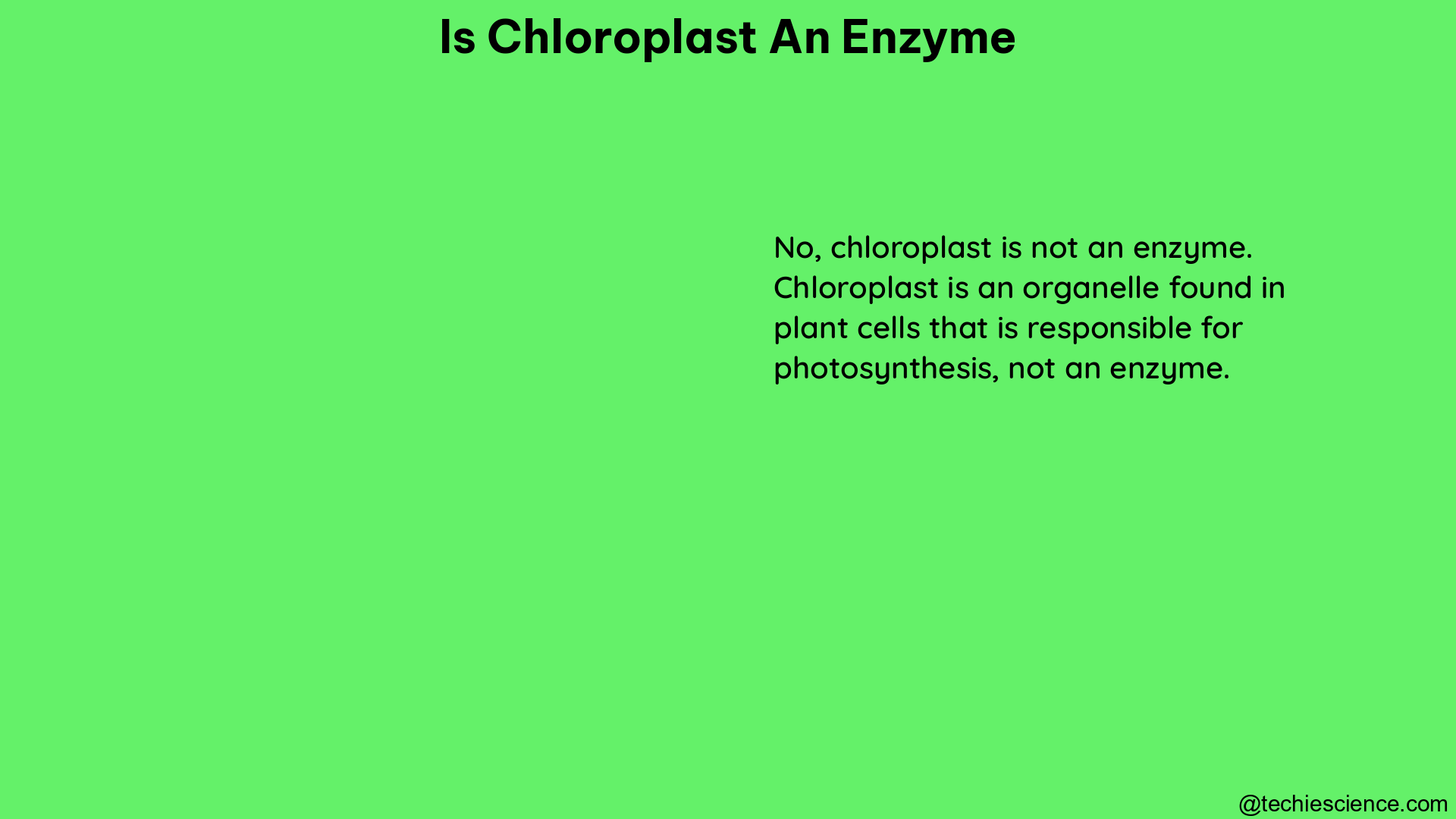Summary
Chloroplasts are not enzymes, but rather organelles found in the cells of plants and algae that play a crucial role in photosynthesis. They contain various structures, including the thylakoid membrane and the stroma, which house different components of the photosynthetic process. While chloroplasts contain enzymes involved in various metabolic pathways, the chloroplast itself is not an enzyme. It is an organelle that is essential for the conversion of light energy into chemical energy, with its own genetic material and translation machinery.
Understanding the Structure and Function of Chloroplasts

Chloroplasts are specialized organelles found in the cells of plants and algae, responsible for the process of photosynthesis. These organelles are typically green in color due to the presence of chlorophyll, a pigment that absorbs light energy from the sun.
The Thylakoid Membrane
The thylakoid membrane is a crucial component of the chloroplast, as it is the site of the light-dependent reactions of photosynthesis. This membrane contains a variety of pigments, including chlorophyll and carotenoids, which are responsible for absorbing light energy. The absorbed energy is then used to power the creation of ATP and NADPH, two high-energy molecules that provide the energy needed for the carbon fixation process.
The thylakoid membrane is organized into a series of stacked structures called grana, which are connected by regions called the stroma lamellae. This intricate structure maximizes the surface area available for the light-dependent reactions, allowing the chloroplast to efficiently capture and convert light energy.
The Stroma
The stroma is the fluid-filled space surrounding the thylakoid membrane within the chloroplast. This region contains a variety of enzymes responsible for the carbon fixation process, also known as the Calvin cycle. These enzymes, such as ribulose-1,5-bisphosphate carboxylase/oxygenase (RuBisCO), are responsible for the assimilation of carbon dioxide and the production of organic compounds, such as glucose, that can be used by the plant for energy and growth.
The stroma also contains the chloroplast’s own genetic material, known as the chloroplast genome. This genome encodes for a variety of proteins, including those involved in the light-dependent and light-independent reactions of photosynthesis, as well as the chloroplast’s own translation machinery.
Chloroplast Translation and Regulation
Chloroplasts have their own translation machinery, which is essential for the synthesis of proteins needed for photosynthesis and other metabolic pathways. This process is highly regulated, as it intersects with the organellar RNA and protein metabolism, making it a critical point for the regulation of gene expression in response to internal and external cues.
The chloroplast translation process is influenced by a variety of factors, including light intensity, nutrient availability, and environmental stresses. These factors can modulate the expression of genes involved in photosynthesis, allowing the chloroplast to adapt to changing conditions and optimize its function.
Chloroplasts and Enzymes
While chloroplasts contain a variety of enzymes involved in various metabolic pathways, the chloroplast itself is not an enzyme. Enzymes are specialized proteins that catalyze specific chemical reactions, whereas chloroplasts are organelles that provide the necessary environment and resources for these enzymatic reactions to occur.
The enzymes found within the chloroplast are responsible for a wide range of functions, including:
- Light-dependent reactions: Enzymes involved in the light-dependent reactions of photosynthesis, such as those responsible for the electron transport chain and the production of ATP and NADPH.
- Carbon fixation: Enzymes involved in the Calvin cycle, such as RuBisCO, which catalyze the assimilation of carbon dioxide and the production of organic compounds.
- Pigment synthesis: Enzymes involved in the synthesis of chlorophyll and carotenoids, which are essential for the absorption of light energy.
- Lipid metabolism: Enzymes involved in the synthesis and metabolism of lipids, which are important for the structure and function of the thylakoid membrane.
- Protein synthesis: Enzymes involved in the translation of chloroplast-encoded proteins, as well as the import and processing of nuclear-encoded proteins.
These enzymes work in concert within the chloroplast to facilitate the overall process of photosynthesis and other metabolic pathways. However, the chloroplast itself is not an enzyme, but rather an organelle that provides the necessary environment and resources for these enzymatic reactions to occur.
Regulation of Chloroplast Function
The function of chloroplasts is tightly regulated in response to various environmental and internal cues. This regulation occurs at multiple levels, including the transcriptional, post-transcriptional, and post-translational levels.
Transcriptional Regulation
The chloroplast genome encodes a variety of genes involved in photosynthesis and other metabolic pathways. The expression of these genes is regulated by a complex network of transcription factors and regulatory elements, which can respond to changes in light intensity, nutrient availability, and other environmental factors.
For example, the expression of genes encoding the light-harvesting complex proteins can be upregulated in response to low light conditions, allowing the chloroplast to optimize its light-capturing capabilities. Conversely, the expression of genes involved in carbon fixation can be downregulated under high-light conditions to prevent photodamage.
Post-transcriptional Regulation
In addition to transcriptional regulation, the expression of chloroplast-encoded genes is also regulated at the post-transcriptional level. This includes the processing, stability, and translation of chloroplast mRNAs, as well as the import and processing of nuclear-encoded proteins.
For instance, the stability of chloroplast mRNAs can be modulated by RNA-binding proteins, which can protect the mRNAs from degradation or facilitate their translation. The import and processing of nuclear-encoded proteins, such as those involved in the light-harvesting complex, can also be regulated to ensure the proper assembly and function of the chloroplast.
Post-translational Regulation
The activity of chloroplast-encoded enzymes can also be regulated at the post-translational level. This includes the reversible modification of enzymes, such as phosphorylation or redox-dependent changes, which can alter their catalytic activity or subcellular localization.
For example, the activity of RuBisCO, the key enzyme in the Calvin cycle, can be regulated by post-translational modifications that modulate its affinity for carbon dioxide and oxygen. This allows the chloroplast to adjust the balance between carbon fixation and photorespiration in response to changes in environmental conditions.
Conclusion
In summary, chloroplasts are not enzymes, but rather specialized organelles found in the cells of plants and algae that play a crucial role in the process of photosynthesis. While chloroplasts contain a variety of enzymes involved in various metabolic pathways, the chloroplast itself is an organelle that provides the necessary environment and resources for these enzymatic reactions to occur.
Chloroplasts are highly complex and dynamic structures, with their own genetic material and translation machinery. The function of chloroplasts is tightly regulated at multiple levels, including transcriptional, post-transcriptional, and post-translational, in response to various environmental and internal cues. This regulation allows the chloroplast to adapt to changing conditions and optimize its photosynthetic efficiency, ensuring the survival and growth of the plant or algal cell.
Reference:
- Jarvis, P., & López-Juez, E. (2013). Biogenesis and homeostasis of chloroplasts and other plastids. Nature Reviews Molecular Cell Biology, 14(12), 787-802.
- Rochaix, J. D. (2011). Regulation of photosynthetic electron transport. Biochimica et Biophysica Acta (BBA)-Bioenergetics, 1807(3), 375-383.
- Pogson, B. J., & Albrecht, V. (2011). Genetic dissection of chloroplast biogenesis and development: an overview. Plant Physiology, 155(4), 1545-1551.
- Eberhard, S., Finazzi, G., & Wollman, F. A. (2008). The dynamics of photosynthesis. Annual Review of Genetics, 42, 463-515.
- Jarvis, P. (2008). Targeting of nucleus-encoded proteins to chloroplasts in plants. New Phytologist, 179(2), 257-285.

Hello, I am Bhairavi Rathod, I have completed my Master’s in Biotechnology and qualified ICAR NET 2021 in Agricultural Biotechnology. My area of specialization is Integrated Biotechnology. I have the experience to teach and write very complex things in a simple way for learners.